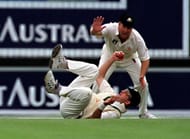The outcome of India’s 2014 tour of England is not something Mahendra Singh Dhoni would love to include in his resume. After drawing the first test, India went on to win the second test at Lord’s, however, it turned out to be the same old story from there.
The hosts bounced back with a 266-run victory in the third Test and eventually wrapped up the five-match series 3-1. Murali Vijay’s and Ajinkya Rahane’s overseas prowess along with Bhuvneshwar Kumar’s all-round skills were the positives from the series, while Virat Kohli’s disastrous run with the bat in the swinging conditions became a talking point for the critics.
It is 2018 summer, and the Indians are back in England’s den for another five-match Test series. Three tests are over, with the score-line reading 2-1 in favor of the hosts. After a closely contested first test, the #1 test team faced an innings defeat in the next, before they fought back in the Trent Bridge test and kept the series alive.
How strong is the current Indian test line-up?
So how better is India’s current test line-up compared to that of in 2014? Have the visitors really rectified the issues of the past and come with a stronger team this time?
Virat Kohli has evolved leaps and bounds as a Test batsman, compared to what he was in his last tour to England. However, batting overall looks vulnerable this time, with India’s Mr. Dependent in overseas conditions, Murali Vijay already on the bench due to a string of poor performances.
Hardik Pandya might not be the next Kapil Dev, but he has performed way better than Stuart Binny, India’s then all-round pacer. The bowling attack looks pretty much similar, with Ishant Sharma leading the pace attack, but is more experienced, and also potent with the inclusion of Jasprit Bumrah.
Even in the absence of Bhuvneshwar Kumar, Indian bowlers took all 20 wickets in the two Tests, with pacers taking 19 of the 20 wickets in the last Test, which definitely shows the improvement in their quality. But the question is, do they really have it in them to become the best touring team?
What needs to be done to be the best touring team?
We have to acknowledge the fact that these days all teams struggle in overseas conditions. In the recent test series, South Africa failed to cope with the spinning tracks offered by Sri Lanka and was whitewashed by the hosts (2-0).
England was obliterated in their last outing to India, ending the tour with a score-line of 0-4. These days, even the mighty Aussies rarely put up a fight away from home. To perform across the world has become a mission impossible for most teams.
However, in the last couple of decades, there was one team which used to achieve this ‘herculean task’ without much fuss. A team that used take their opponents head-on, regardless of the arena of the contest - The Australia of the early 2000s.

So what made them successful in conditions alien to them? Yes, they had a world-class bowling attack and a batting line-up that included the likes of Ricky Ponting and Mathew Hayden, but that wasn’t the only reason why they were so successful all around the world.
They hardly missed any chance to gain an advantage in a match. Whenever an opportunity was presented to them, they grabbed it with both hands.
They had the safest pair of gloves in Adam Gilchrist, who would pluck catches out of thin air, converting half-chances into major breakthroughs. The slip-cordon led by Mark Waugh, who had an impeccable technique when it comes to catching, rarely disappointed bowlers.
Be it, Andrew Symonds or Ricky Ponting, the fielders would uproot the stumps at any given opportunity. On a day when their bowling or batting went off-colour, their fielding stood up to the rescue.
To understand how impactful fielding is, let us look at the stats of the first Test of the ongoing series. England was reduced to 87-7 in the second innings at one stage when the relatively inexperienced Sam Curran took the crease.
Shikar Dhawan dropped Curran when the England scoreboard read 107-7, and it proved too costly. Curran made 63 runs, which pushed India’s target close to 200, the visitors eventually ended up losing the game by 31 runs.
Slip catching was woeful from other Indians as well, including Ajinkya Rahane, who is otherwise known to have a safe pair of hands at slips while fielding for spinners.
The catching was not any better from the English side as well. Virat Kohli was dropped an unpardonable four times in the first Test, and he went on to score 149 runs in the first innings. Across the three Tests, about 15 catches were dropped by the Poms.
Indian catching showed significant improvement in the third test, with KL Rahul and Rishabh Pant grabbing a record seven catches each, while England went on with their dropping spree, eventually leading to India’s victory.
Blame the IPL or the lack of green pitches across the country for the lack of patience and skill of the players, but until or unless Indians start to latch on to their chances, the dream of becoming the best touring team will remain far-fetched. The Indian catching in the third test shouldn’t be an aberration. They should do it more, on a consistent basis.
India does not necessarily need a James Anderson or Dale Steyn to win matches outside Asia; they just need to be efficient with their available resources.
Brand-new app in a brand-new avatar! Download CricRocket for fast cricket scores, rocket flicks, super notifications and much more! 🚀☄️
